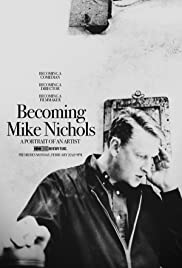
BECOMING MIKE NICHOLS
US, 2016, 70 minutes, Colour.
Mike Nichols, Jack O' Brien.
Directed by Douglas Mc Grath.
This is a brief, very entertaining documentary about Director, Mike Nichols – and one wishes that he could have gone on longer. It was made just before Mike Nichols’ death, two interviews with his friend, theatre director, Jack O’ Brien, one simply with O’ Brien himself, the other before an audience. It was directed by film and theatre director Douglas Mc Grath. Nichols died in 2014 at the age of 83.
The documentary is divided into straightforward chapters. However, the chapter on Nichols’ early life comes later in the film. His father migrated from Germany to the US at the end of the 1930s, followed a year later by his two sons, then by his wife. Nichols was a boy, could not speak English, went to school but said he learned much of his language from watching the movies. He also saw Jessica Tandy and Marlon Brando in A Streetcar Named Desire which made a profound impression.
However, his first success was in improv comedy with Elaine May. There are some very enjoyable excerpts from their routines incorporated into this film (making audiences want to see more, hear more, laugh out loud at their extraordinary ability to improvise).
Nichols was invited to direct Neil Simon’s Barefoot in the Park with quite some discussion about Simon’s lack of confidence, rehearsals, the involvement of Robert Redford, its success. Simon also mentions his directing of Neil Simon’s The Odd Couple on stage and difficulties with Walter Matthau. Unfortunately, the discussions on Nichols’ extensive theatre career are not included.
As regards film, there is discussion only of his first two films, Who’s Afraid of Virginia Woolf and The Graduate. He speaks quite candidly of his having to learn a lot of craft for cinema for his first film, his relationship with Richard Burton and Elizabeth Taylor and working with them, especially for key scenes, difficulties with Jack L. Warner, and the range of Oscar nominations and awards.
It is also very interesting on the origins of The Graduate, collaboration with Buck Henry on the screenplay, the testing of Dustin Hoffman for the role and is a perceptive comment on Hoffman’s screen presence and communication. There are discussions of some sequences, including the ending. Particularly interesting are his comments on Simon and Garfunkel’s music, listening to it, then realising that it fitted the film – and the audience seeing the long sequence where he used The Sounds of Silence. There is an amusing tone in his explanation of how Paul Simon came up with Mrs Robinson.
There is, however, an extended tribute in the final credits with covers of play bills of the range of plays he directed on Broadway. There are also posters for the rest of his film features – 22 films over a period of 40 years.
An interesting and enjoyable masterclass on Mike Nichols and his work, touches of humour, some self-deprecation.